A Multi-Platform Online Data-Driven Diagnostic Approach for Macro-Level Sustainability of Homestays
Abstract
1. Introduction
2. Literature Review
2.1. Homestays and Their Sustainable Development
2.2. Online Data in Tourism Research
3. Materials and Methods
3.1. A Multi-Platform Online Data-Driven Diagnostic Model
3.1.1. Social Attention Index
3.1.2. Industry Scale Index
3.1.3. Type Reference Index
3.1.4. Potential Influencing Factors of Homestay Industry Sustainability
- Macroeconomic and Industrial Structure: GDP; output values of the primary, secondary, and tertiary industries; number of nationally recognized high-tech enterprises; and operating income of above-scale service enterprises.
- Cultural and Tourism Development: number of tourist visits, tourism revenue, number of A-level scenic spots, number of high-star hotels, and number of museums.
- Local Population Base: permanent resident population, urbanization rate, number of participants in basic pension insurance for urban employees, number of undergraduate and junior college students, and number of preschool and primary school students.
- Resident Income Level: per capita disposable income.
3.2. Data Analysis Methods
3.2.1. Spatial Interpolation Analysis
3.2.2. Standard Deviation Ellipse and Centre of Gravity Shift Analysis
3.2.3. Global Moran’s I Index
3.2.4. Ordinary Least Squares (OLS) and Geographically Weighted Regression (GWR)
4. Results
4.1. Spatiotemporal Patterns of Social Attention of the Homestay Industry
4.1.1. Temporal Evolution of Social Attention of the Homestay Industry
4.1.2. Spatial Differentiation of Social Attention
4.2. Spatiotemporal Patterns of Homestay Industry Scale
4.2.1. Temporal Evolution of Homestay Industry Scale
4.2.2. Spatial Differentiation of Homestay Industry Scale
- (1)
- Number of Active Homestay Enterprises: The provincial distribution was random (Table 1). Zhejiang and Sichuan had the highest amount (Figure 8a), followed by four traditional tourism powerhouses. At the municipal level, East China showed strong agglomeration (Table 1), while other regions were randomly distributed. Xi’an, Garzê, and Harbin were major hotspots. Cold spots were mostly inland western cities or scattered across less tourism-driven eastern areas (Figure 9a).
- (2)
- Regional Density of Active Homestay Enterprises: Significant clustering was observed at the provincial level. Zhejiang led with 20.451 enterprises per 100 km2 (Figure 8b), followed by Beijing and Shanghai. Most provinces west of the Hu Huanyong Line had fewer than 1 per 100 km2. At the municipal level (Figure 9b), clustering was observed in North, Northeast, Central, and Northwest China. Capital cities tended to have the highest densities. Xiamen and Zhoushan exceeded 20, meantime Xi’an, Shenzhen, and Beihai exceeded 10. However, most cities had fewer than 1 per 100 km2.
- (3)
- Number of Active Homestay Enterprises per 10,000 Population: Due to China’s highly uneven population distribution, considering per capita figures is necessary for assessing enterprise intensity. In many sparsely populated western regions, though the absolute total number and regional density were low, the per capita number was high. At the provincial level (Figure 8c), Tibet ranked first, followed by Xinjiang and Yunnan. Jiangsu, Fujian, and Ningxia were the lowest among non-municipalities. At the municipal level (Figure 9c), clustering was observed in East, Central, South, and Southwest China. Garzê led with 148.313 per 10,000 population, followed by Diqing and Aba. Nearly two-thirds of cities had fewer than 3 per 10,000 population, and one-third have fewer than 1, mostly in agricultural provinces.
- (4)
- Number of Medium and Large Active Homestay Enterprises: Evaluating homestay industry requires considering enterprise scale. While small homestays suit idle capital and enable local branding, larger enterprises promote standardization and mitigate risk. Medium and large homestay enterprises accounted for 0.705% of the total. Nationwide, 900 enterprises had registered capital over 10 million RMB, and 2238 exceeded 5 million. Shaanxi, Zhejiang, and Anhui had the most medium and large homestay enterprises, while Qinghai and Ningxia had the fewest (Figure 10a). In total, 87.35% of cities had fewer than 10, and 76.47% had 5 or fewer. Enterprise scale showed significant clustering (Figure 10b).
4.3. Regional Typology for Sustainable Development of the Homestay Industry
4.4. Factors Influencing the Homestay Industry Sustainability
4.4.1. Factors Affecting the Homestay Social Attention
4.4.2. Factors Influencing the Homestay Industry Scale
5. Discussion
5.1. Model Validity
5.2. The Sustainability of the Homestay Industry
6. Conclusions and Implications
6.1. Conclusions
6.2. Implications
6.2.1. Methodological Implications
6.2.2. Theoretical Implications
6.2.3. Practical Implications
7. Limitations and Future Research
Author Contributions
Funding
Institutional Review Board Statement
Informed Consent Statement
Data Availability Statement
Conflicts of Interest
Abbreviations
| GWR | Geographically Weighted Regression |
| OLS | Ordinary Least Squares |
References
- UNWTO. UNWTO General Assembly Documents. 2005. Available online: https://www.e-unwto.org/toc/unwtogad/2005/1 (accessed on 20 June 2025).
- Zhang, H.; Xia, X.; Wang, S.; Xu, C.; Li, Y.; Yang, Y. Spatial dynamics and economic impacts of shared accommodations on urban housing and hotel markets. J. Destin. Mark. Manag. 2025, 37, 101023. [Google Scholar] [CrossRef]
- Lee, S.A.; Jeong, M.; Jeon, M.M. Effects of experiential stimuli on customers’ responses: An example of bed and breakfast websites. J. Hosp. Tour. Technol. 2016, 7, 390–404. [Google Scholar] [CrossRef]
- KC, B.; Thapa, S. The power of homestay tourism in fighting social stigmas and inequities. J. Sustain. Tour. 2024, 33, 1430–1448. [Google Scholar] [CrossRef]
- Kamisan Pusiran, A.; Xiao, H. Challenges and Community Development: A Case Study of Homestay in Malaysia. Asian Soc. Sci. 2013, 9, 1–17. [Google Scholar] [CrossRef]
- Pasanchay, K.; Schott, C. Community-based tourism homestays’ capacity to advance the Sustainable Development Goals: A holistic sustainable livelihood perspective. Tour. Manag. Perspect. 2021, 37, 100784. [Google Scholar] [CrossRef]
- Grand View Research. Vacation Rental Market Size, Share & Trends Analysis Report by Booking Mode (Online, Offline), by Accommodation Type (Home, Apartment, Resort/Condominium), by Region, and Segment Forecasts, 2024–2030. Available online: https://www.grandviewresearch.com/industry-analysis/vacation-rental-market (accessed on 28 August 2025).
- About Us–Airbnb Newsroom. Available online: https://news.airbnb.com/about-us/ (accessed on 28 August 2025).
- VICSDF Research Center. Annual Report on Sustainable Development. Available online: https://www.vicsdf.com/doc/7113ad7013b850d1 (accessed on 21 May 2025).
- China Industry Research Institute. Market Analysis and Venture Capital Trends Research Report on the Homestay Industry 2025. Available online: https://big5.chinairn.com/hyzx/20250218/170628371.shtml (accessed on 28 August 2025).
- Fastdata. China Homestay Industry Development Trends Report 2025. Available online: http://www.ifastdata.com/2025/03/17/fastdata%e6%9e%81%e6%95%b0%ef%bc%9a%e4%b8%ad%e5%9b%bd%e6%b0%91%e5%ae%bf%e8%a1%8c%e4%b8%9a%e5%8f%91%e5%b1%95%e8%b6%8b%e5%8a%bf%e6%8a%a5%e5%91%8a2025/ (accessed on 28 August 2025).
- Qiu, W.W.; Yu, H.T.; Lin, P.M.; Au, W.C.W. Evaluating rural homestay accommodations in China using the hospitality index: An online review–based approach. Int. J. Hosp. Manag. 2024, 121, 103792. [Google Scholar] [CrossRef]
- Kunjuraman, V.; Hussin, R. Challenges of community-based homestay programme in Sabah, Malaysia: Hopeful or hopeless? Tour. Manag. Perspect. 2017, 21, 1–9. [Google Scholar] [CrossRef]
- Xiang, Y.; Zhang, B.; Hou, Y.; Li, F. Identifying the specific features, determinants, and suitability of green homestay inn distribution in rural China. J. Rural Stud. 2025, 119, 103760. [Google Scholar] [CrossRef]
- ChinaIRN. Risk Investment Situation and Investment and Financing Strategy Guidance of B & B Industry in 2025. Available online: https://www.chinairn.com/news/20250519/112439708.shtml (accessed on 21 May 2025).
- Fu, X.; Pan, L.; Liu, S. To store or not: Online cost optimization for running big data jobs on the cloud. Futur. Gener. Comput. Syst. 2024, 156, 42–52. [Google Scholar] [CrossRef]
- Zheng, J.; Huang, L. Characterizing the spatiotemporal patterns and key determinants of homestay industry agglomeration in rural China using multi geospatial datasets. Sustainability 2022, 14, 7242. [Google Scholar] [CrossRef]
- Kim, J.J. Brand portfolio extension of international hotel chains: A perspective on consumer confusion and consumer decision-making process. Int. J. Contemp. Hosp. Manag. 2024, 36, 3093–3111. [Google Scholar] [CrossRef]
- Xu, X.; Luo, Y. What makes customers “click”? An analysis of hotel list content using deep learning. Int. J. Hosp. Manag. 2023, 114, 103581. [Google Scholar] [CrossRef]
- Sung, E.; Kim, H.; Lee, D. Why do people consume and provide sharing economy accommodation?—A sustainability perspective. Sustainability 2018, 10, 2072. [Google Scholar] [CrossRef]
- Wang, J.; Chow, Y.S.; Biljecki, F. Insights in a city through the eyes of Airbnb reviews: Sensing urban characteristics from homestay guest experiences. Cities 2023, 140, 104399. [Google Scholar] [CrossRef]
- Chiu, C.N. How can managerial efficiency be improved? Evidence from the bed and breakfast industry. Tour. Manag. Perspect. 2018, 27, 111–124. [Google Scholar] [CrossRef]
- Huan, Y.; Yu, Q.; He, Z.; Zhao, Q.; Zhang, Z. Spatial differentiation and influencing factors of price classification of rural homestays in Shaanxi Province. Econ. Geogr. 2023, 43, 204–211. [Google Scholar] [CrossRef]
- Zhang, X.Y.; Zhang, Q.; Han, J.L. The symbiotic relationship between homestays and local community: Multiple case studies based on rooting theory. Hum. Geogr. 2022, 37, 50–59. [Google Scholar] [CrossRef]
- Mura, P. Perceptions of authenticity in a Malaysian homestay: A narrative analysis. Tour. Manag. 2015, 51, 225–233. [Google Scholar] [CrossRef]
- Mellors, J.; Egdell, V. Affected and Intrinsic Authenticity: Navigating Internalized Gay Ageism on LGBTQ+ Homestay Platforms. Gend. Work Organ. 2025, 32, 1569–1579. [Google Scholar] [CrossRef]
- Deng, L.; Li, C.; Deng, Q. Time of day effects on consumers’ online review characteristics: Evidence from the homestay platform. J. Hosp. Tour. Manag. 2024, 61, 115–134. [Google Scholar] [CrossRef]
- Kumar, J.; Chandra, P. Exploring psychological mechanisms behind tourists’ sustainable behaviours at homestays. J. Sustain. Tour. 2024, 32, 2500–2517. [Google Scholar] [CrossRef]
- Tavakoli, R.; Mura, P.; Rajaratnam, S.D. Social capital in Malaysian homestays: Exploring hosts’ social relations. Curr. Issues Tour. 2017, 20, 1028–1043. [Google Scholar] [CrossRef]
- Peng, L.; Xu, H.; Lu, J.; Luo, J.; Zhan, H. An Integrated Approach with CLFPR-Based ANP and Fuzzy TOPSIS for Evaluating Business Performance of Rural Homestays: Study from China. Sustainability 2023, 15, 538. [Google Scholar] [CrossRef]
- Eugenio-Martin, J.L.; Cazorla-Artiles, J.M.; González-Martel, C. On the determinants of Airbnb location and its spatial distribution. Tour. Econ. 2019, 25, 1224–1244. [Google Scholar] [CrossRef]
- Chen, H.T.; Chen, K.S.; Tseng, H.P.; Chang, W.F. Usage behavior causal model construction for B&B-owned websites—From the B&B owner/operator perspective. J. Qual. Assur. Hosp. Tour. 2014, 15, 399–424. [Google Scholar] [CrossRef]
- Yang, Y.; Mao, Z. Location Advantages of Lodging Properties: A Comparison between Hotels and Airbnb Units in an Urban Environment. Ann. Tour. Res. 2020, 81, 102861. [Google Scholar] [CrossRef]
- Wang, Z.Y.; Zhang, S.; Liu, W.F. When a villager is a rural homestay operator: Role expectation research using the machine learning model? Curr. Issues Tour. 2025, 28, 1002–1020. [Google Scholar] [CrossRef]
- Janjua, Z.U.A.; Krishnapillai, G.; Rahman, M. A systematic literature review of rural homestays and sustainability in tourism. Sage Open. 2021, 11, 1–17. [Google Scholar] [CrossRef]
- Shin, H.W.; Fan, A.; Lehto, X. Peer-to-peer accommodation: A meta-analysis of factors affecting customer satisfaction and loyalty. Int. J. Tour. Res. 2021, 23, 581–596. [Google Scholar] [CrossRef]
- Adamiak, C. Mapping Airbnb Supply in European Cities. Ann. Tour. Res. 2018, 71, 67–71. [Google Scholar] [CrossRef]
- Domènech, A.; Zoğal, V. Geographical Dimensions of Airbnb in Mountain Areas: The Case of Andorra. J. Rural Stud. 2020, 79, 361–372. [Google Scholar] [CrossRef]
- Zhang, H.; Lu, L.; Zhang, D.; Yu, H.; Zhang, X. Spatial pattern and contributing factors of homestay inns in the area around Mogan Mountain. Geogr. Res. 2019, 38, 2695–2715. [Google Scholar] [CrossRef]
- Hei, Y.; Sui, Y.; Gao, W.; Zhao, M.; Hu, M.; Gao, M. Geodetector-based analysis of spatiotemporal distribution characteristics and influencing mechanisms for rural homestays in Beijing. Land 2025, 14, 997. [Google Scholar] [CrossRef]
- Yang, Y.; Tan, K.P.S.; Li, X.R. Antecedents and consequences of home-sharing stays: Evidence from a nationwide household tourism survey. Tour. Manag. 2019, 70, 15–28. [Google Scholar] [CrossRef]
- Li, Y.; Xia, L.; Wang, L.; Qiu, M.; Utomo, S. How are rural homestays achieving sustainable development in the post-COVID-19 period: Value co-creation by operators, tourists, and government. Sustainability 2024, 16, 1088. [Google Scholar] [CrossRef]
- Suanpang, P.; Jamjuntr, P.; Lertkornkitja, A.; Jittithavorn, C. Can Optimized Genetic Algorithms Improve the Effectiveness of Homestay Recommendation Systems in Smart Villages? A Case of Thailand. Int. J. Tour. Res. 2024, 26, e2762. [Google Scholar] [CrossRef]
- Xiang, Z.; Du, Q.; Ma, Y.; Fan, W. A comparative analysis of major online review platforms: Implications for social media analytics in hospitality and tourism. Tour. Manag. 2017, 58, 51–65. [Google Scholar] [CrossRef]
- Acharya, M.; Mohbey, K.K. Exploring the evolution, progress, and future of point-of-interest recommendation over location-based social network: A comprehensive review. GeoInformatica 2024, 29, 305–350. [Google Scholar] [CrossRef]
- Chen, J.; Shoval, N.; Stantic, B. Tracking tourist mobility in the big data era: Insights from data, theory, and future directions. Tour. Geogr. 2024, 26, 1381–1411. [Google Scholar] [CrossRef]
- Li, S.; Li, Y.; Liu, C.; Fan, N. How do different types of user-generated content attract travelers? Taking story and review on Airbnb as the example. J. Travel Res. 2024, 63, 371–387. [Google Scholar] [CrossRef]
- Gholamhosseinzadeh, M.S. Theorizing vloggers’ approaches and practices in travel vlog production through grounded theory. J. Hosp. Mark. Manag. 2023, 32, 196–223. [Google Scholar] [CrossRef]
- Mazare, M.; Simion, C.-P. The Influence of Web 2.0 Tools on the Sustainable Development of E-Commerce: Empirical Evidence from European Union Countries. Sustainability 2025, 17, 6237. [Google Scholar] [CrossRef]
- Kanwal, B.; Rehman, S.U.; Imran, A.; Shaukat, R.S.; Li, J.; Alzahrani, A.; Alghamdi, A.D.; Alarfaj, F.K. Opinion mining from online travel reviews: An exploratory investigation on Pakistan major online travel services using natural language processing. IEEE Access 2023, 11, 29934–29945. [Google Scholar] [CrossRef]
- Oh, M.; Kim, S. Role of emotions in fine-dining restaurant online reviews: The applications of semantic network analysis and a machine learning algorithm. Int. J. Hosp. Tour. Adm. 2021, 23, 875–903. [Google Scholar] [CrossRef]
- Qin, Y.; Luo, C.; Ngai, E.W.T. Deconstructing customer satisfaction recipes: A dynamic configurational framework leveraging the power of online reviews in tourism contexts. Tour. Manag. 2025, 110, 105181. [Google Scholar] [CrossRef]
- Boyle, S.C.; Earle, A.M.; LaBrie, J.W.; Ballou, K. Facebook dethroned: Revealing the more likely social media destinations for college students’ depictions of underage drinking. Addict. Behav. 2017, 65, 63–67. [Google Scholar] [CrossRef]
- Shao, H.; Zhang, Y.; Li, W. Extraction and analysis of city’s tourism districts based on social media data. Comput. Environ. Urban Syst. 2017, 65, 66–78. [Google Scholar] [CrossRef]
- Liang, W.; Ahmad, Y.; Mohidin, H.H.B. Spatial pattern and influencing factors of tourism based on POI data in Chengdu, China. Environ. Dev. Sustain. 2024, 26, 10127–10143. [Google Scholar] [CrossRef]
- Ye, X.; Miao, L. Digital transformation and green finance efficiency of tourism enterprises: The effect of credit ratings. Int. Rev. Financ. Anal. 2025, 106, 104527. [Google Scholar] [CrossRef]
- Tiantian, G.; Hailin, C.; Zhou, X.; Ai, S.; Siyao, W. Does corporate digital transformation affect the level of corporate tax avoidance? Empirical evidence from Chinese listed tourism companies. Financ. Res. Lett. 2023, 57, 104271. [Google Scholar] [CrossRef]
- Qiao, H.H.; Wang, C.H.; Chen, M.H.; Su, C.H.J.; Tsai, C.H.K.; Liu, J. Hedonic price analysis for high-end rural homestay room rates. J. Hosp. Tour. Manag. 2021, 49, 1–11. [Google Scholar] [CrossRef]
- Gan, Q.; Liao, L.; Kang, X.; Xu, Z.; Fu, T.; Cao, Y.; Feng, Y.; Dong, J.; Lan, S. Cultural ecosystem services and disservices in protected areas: Hotspots and influencing factors based on tourists’ digital footprints. Ecosyst. Serv. 2024, 70, 101680. [Google Scholar] [CrossRef]
- Dergiades, T.; Mavragani, E.; Pan, B. Google Trends and tourists’ arrivals: Emerging biases and proposed corrections. Tour. Manag. 2018, 66, 108–120. [Google Scholar] [CrossRef]
- Liu, Y.; Shi, J. How inter-city high-speed rail influences tourism arrivals: Evidence from social media check-in data. Curr. Issues Tour. 2019, 22, 1025–1042. [Google Scholar] [CrossRef]
- Xiang, Z.; Pan, B. Travel queries on cities in the United States: Implications for search engine marketing for tourist destinations. Tour. Manag. 2011, 32, 88–97. [Google Scholar] [CrossRef]
- Li, X.; Pan, B.; Law, R.; Huang, X. Forecasting tourism demand with composite search index. Tour. Manag. 2017, 59, 57–66. [Google Scholar] [CrossRef]
- Huang, X.; Zhang, L.; Ding, Y. The Baidu Index: Uses in predicting tourism flows—A case study of the Forbidden City. Tour. Manag. 2017, 58, 301–306. [Google Scholar] [CrossRef]
- Li, H.; Hu, M.; Li, G. Forecasting tourism demand with multisource big data. Ann. Tour. Res. 2020, 83, 102912. [Google Scholar] [CrossRef]
- Song, H.; Qiu, R.T.; Park, J. A review of research on tourism demand forecasting: Launching the Annals of Tourism Research Curated Collection on tourism demand forecasting. Ann. Tour. Res. 2019, 75, 338–362. [Google Scholar] [CrossRef]
- Hu, T.; Wang, H.; Law, R.; Geng, J. Diverse feature extraction techniques in internet search query to forecast tourism demand: An in-depth comparison. Tour. Manag. Perspect. 2023, 47, 101116. [Google Scholar] [CrossRef]
- Li, X.; Law, R. Network analysis of big data research in tourism. Tour. Manag. Perspect. 2020, 33, 100608. [Google Scholar] [CrossRef]
- Mousa Mousa, M.; Abdulrahman Al Moosa, H.; Naim Ayyash, I.; Omeish, F.; Zaiem, I.; Alzahrani, T.; Hammami, S.M.; Zamil, A.M. Big Data Analytics as a Driver for Sustainable Performance: The Role of Green Supply Chain Management in Advancing Circular Economy in Saudi Arabian Pharmaceutical Companies. Sustainability 2025, 17, 6319. [Google Scholar] [CrossRef]
- Bi, J.W.; Wang, Y.; Han, T.Y.; Zhang, K. Exploring the effect of “home feeling” on the online rating of homestays: A three-dimensional perspective. Int. J. Contemp. Hosp. Manag. 2024, 36, 182–217. [Google Scholar] [CrossRef]
- Gunter, U.; Önder, I. Determinants of Airbnb demand in Vienna and their implications for the traditional accommodation industry. Tour. Econ. 2018, 24, 270–293. [Google Scholar] [CrossRef]
- National Bureau of Statistics, Urban Socioeconomic Survey Department. China City Statistical Yearbook; China Statistics Press: Beijing, China, 2024. [Google Scholar]
- Wang, F.; Chen, C.; Xiu, C.; Zhang, P. Location analysis of retail stores in Changchun, China: A street centrality perspective. Cities 2014, 41, 54–63. [Google Scholar] [CrossRef]
- Chen, C.S.; Noorizadegan, A.; Young, D.L.; Chen, C.S. On the selection of a better radial basis function and its shape parameter in interpolation problems. Appl. Math. Comput. 2023, 442, 127713. [Google Scholar] [CrossRef]
- Tang, G.A.; Yang, X. ArcGIS Geographic Information System Spatial Analysis Experimental Course; Science Press: Beijing, China, 2006. [Google Scholar]
- Zhao, Z.W.; Zhao, Z.Q.; Zhang, P. A new method for identifying industrial clustering using the standard deviational ellipse. Sci. Rep. 2023, 13, 578. [Google Scholar] [CrossRef]
- Wang, C.; Ibrahim, H.; Wu, F.; Chang, W. Spatial and temporal evolution patterns and spatial spillover effects of carbon emissions in China in the context of digital economy. J. Environ. Manag. 2025, 373, 123811. [Google Scholar] [CrossRef]
- Chen, P.; Duan, J.; Wang, Y. Spatio-temporal evolution and driving forces of urban gravity centers and ecological security risk gravity centers in China. Ecol. Indic. 2025, 170, 113025. [Google Scholar] [CrossRef]
- Zhou, R.; Chen, J.; Cui, S.; Li, L.; Qian, J.; Zhao, H.; Huang, G. A data-driven framework to identify influencing factors for soil heavy metal contaminations using random forest and bivariate local Moran’s I: A case study. J. Environ. Manag. 2025, 375, 124172. [Google Scholar] [CrossRef] [PubMed]
- Soltani, Z.; Hassani, H.; Esmaeiloghli, S. A deep autoencoder network connected to geographical random forest for spatially aware geochemical anomaly detection. Comput. Geosci. 2024, 190, 105657. [Google Scholar] [CrossRef]
- Gawer, A. Digital platforms’ boundaries: The interplay of firm scope, platform sides, and digital interfaces. Long Range Plann. 2021, 54, 102045. [Google Scholar] [CrossRef]
- Booth, P.; Chaperon, S.A.; Kennell, J.S.; Morrison, A.M. Entrepreneurship in island contexts: A systematic review of the tourism and hospitality literature. Int. J. Hosp. Manag. 2020, 85, 102438. [Google Scholar] [CrossRef]
- Mitra, S.K.; Chattopadhyay, M.; Jana, R.K. Spillover analysis of tourist movements within Europe. Ann. Tour. Res. 2019, 79, 102754. [Google Scholar] [CrossRef]
- Ruiz-Ballesteros, E.; Gonzalez-Portillo, A. Disentangling the relationship between rurality and tourism from a peripheral rural area of Europe. J. Rural Stud. 2025, 115, 103595. [Google Scholar] [CrossRef]
- Krugman, P. Increasing returns and economic geography. J. Polit. Econ. 1991, 99, 483–499. [Google Scholar] [CrossRef]
- Nakamura, S.; Baskaran, A.; Selvarajan, S.K. Impact of Airbnb on the hotel industry in Japan. J. Dest. Mark. Manag. 2024, 31, 100841. [Google Scholar] [CrossRef]
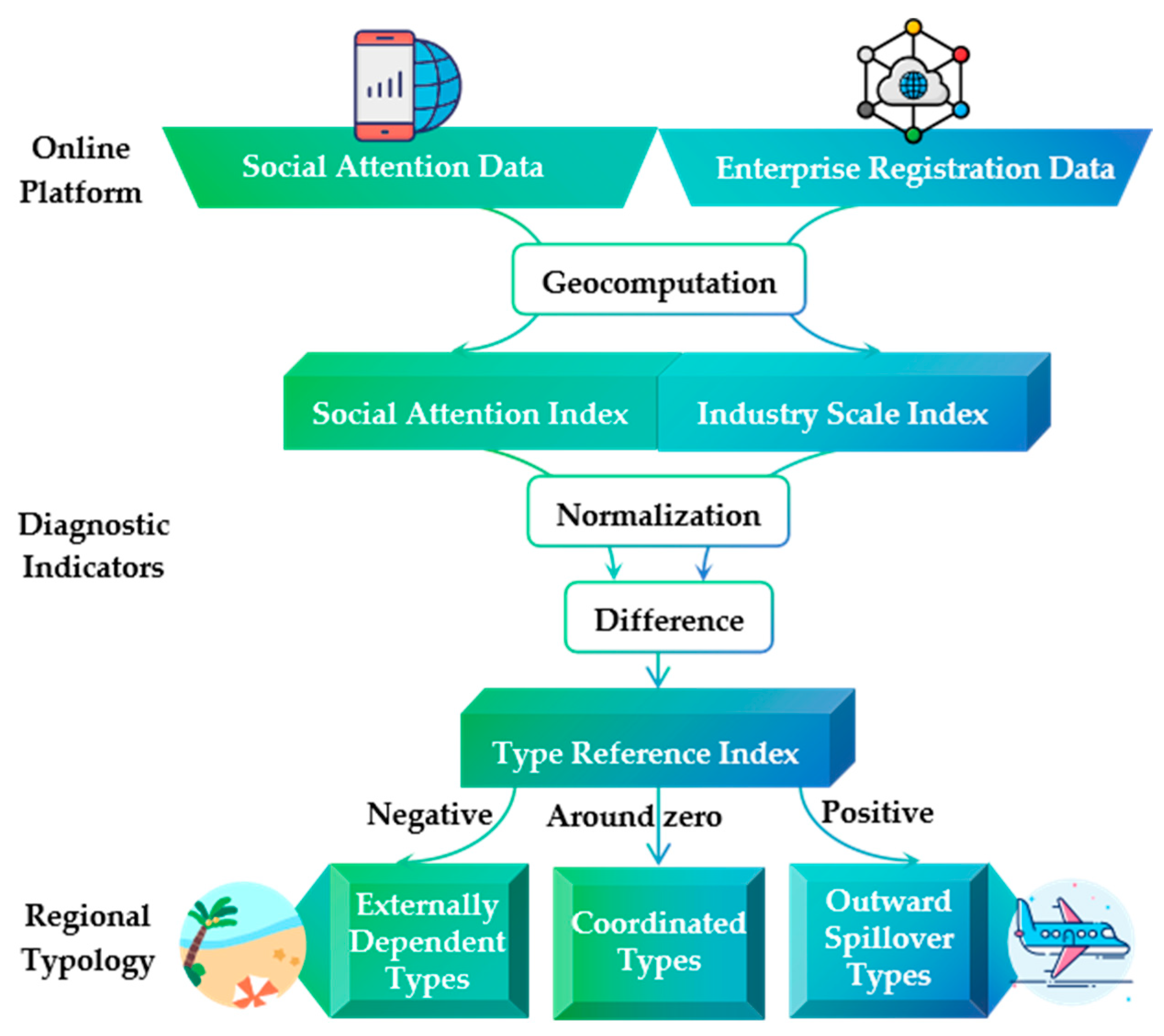
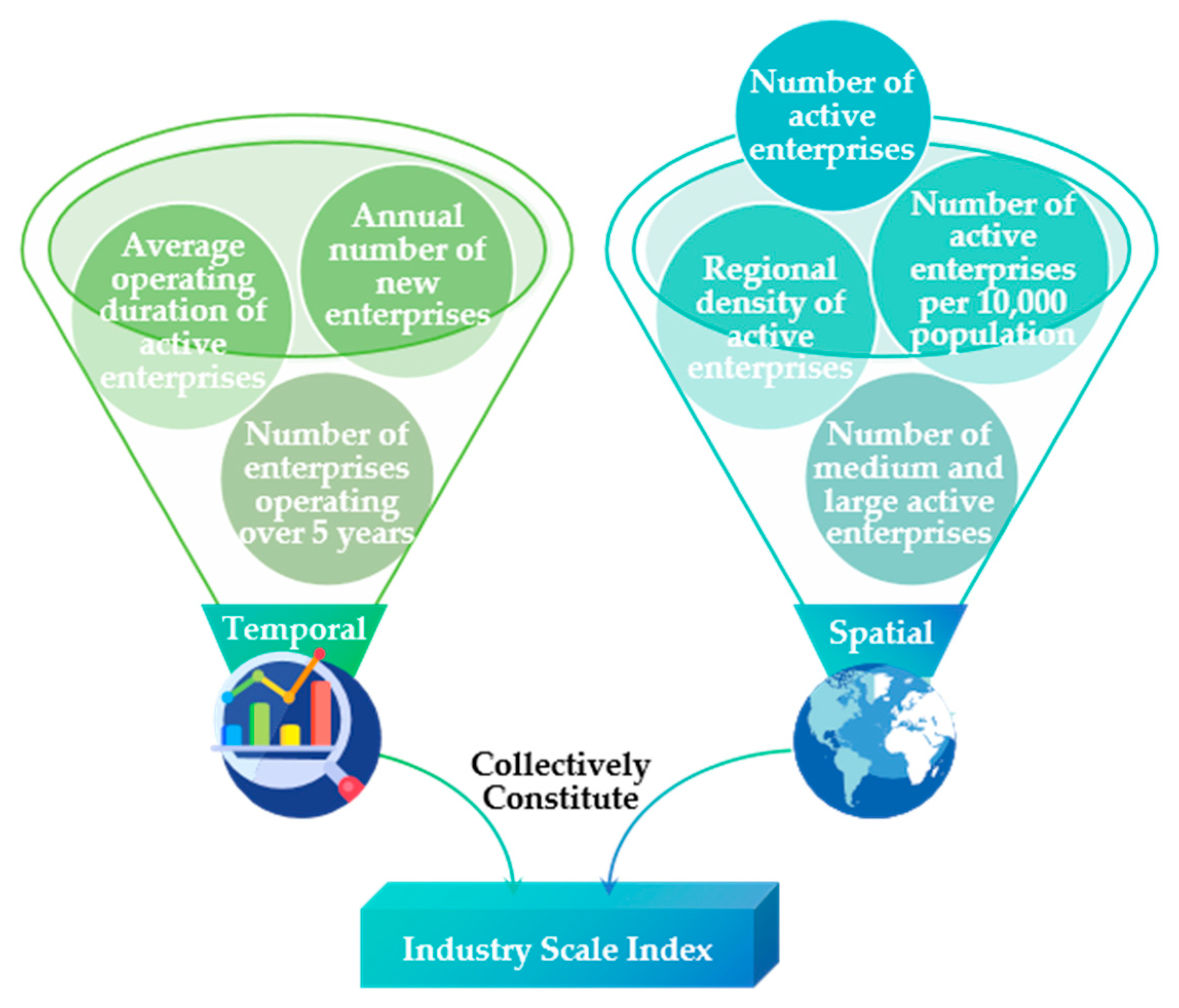
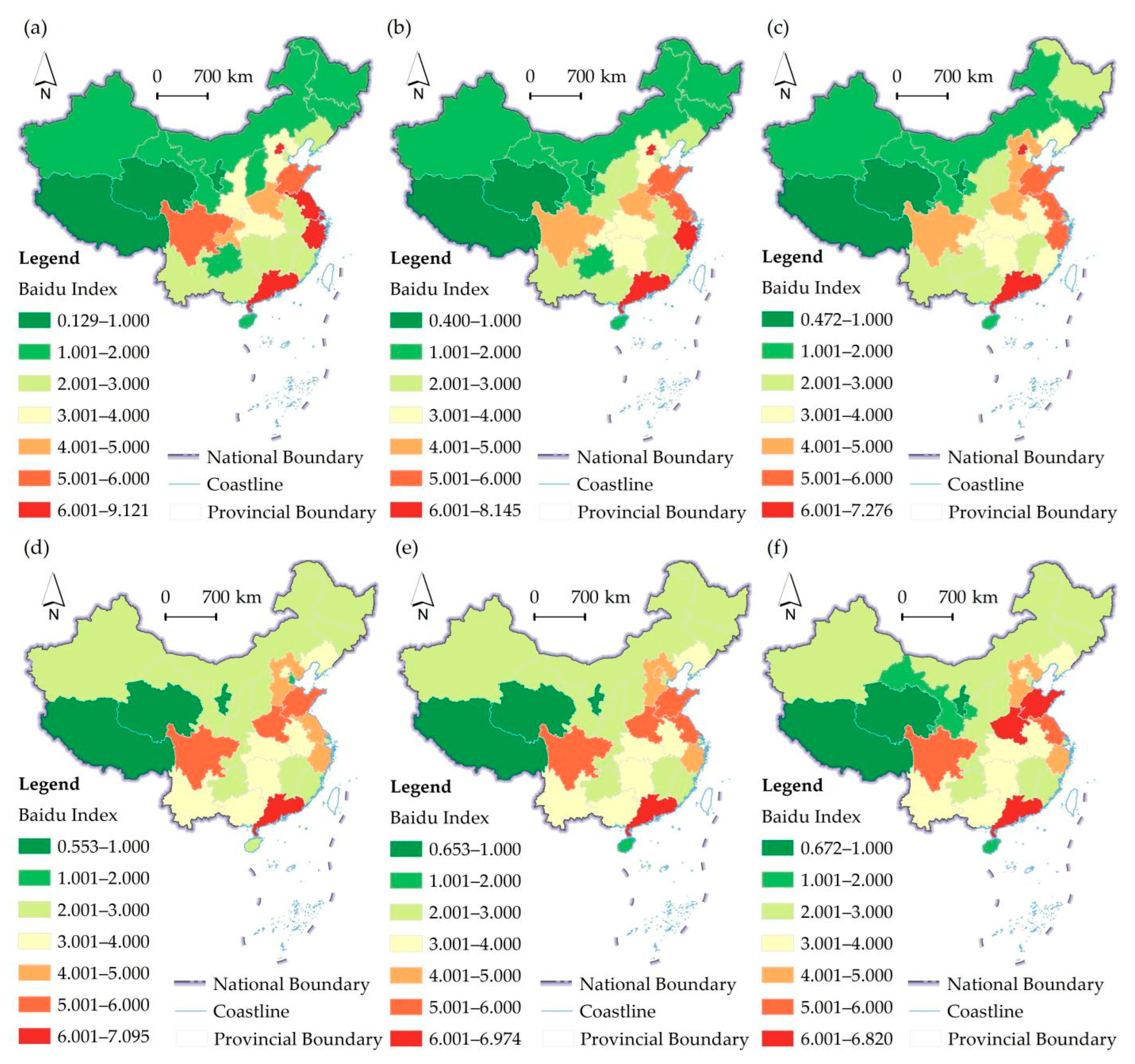
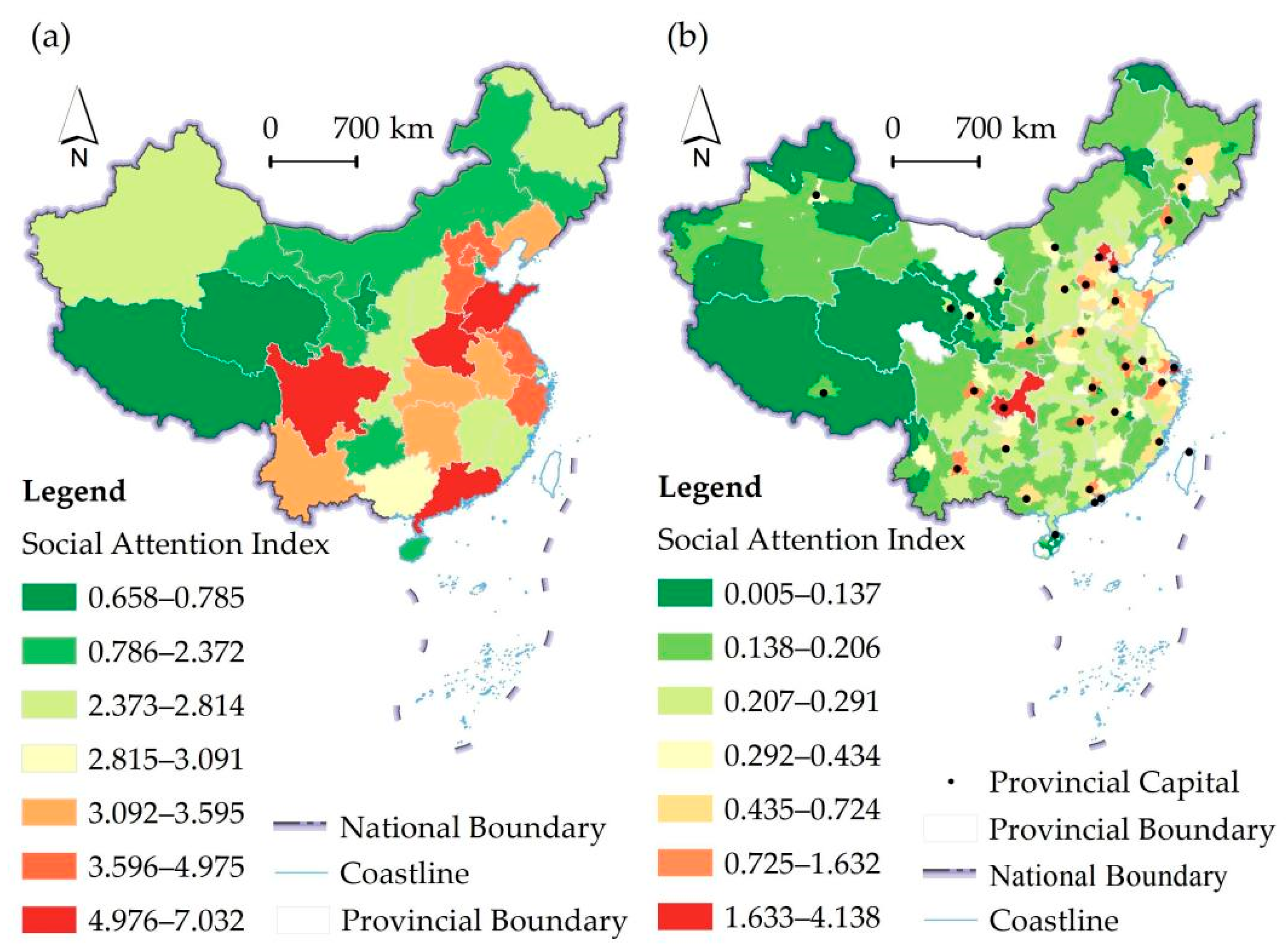
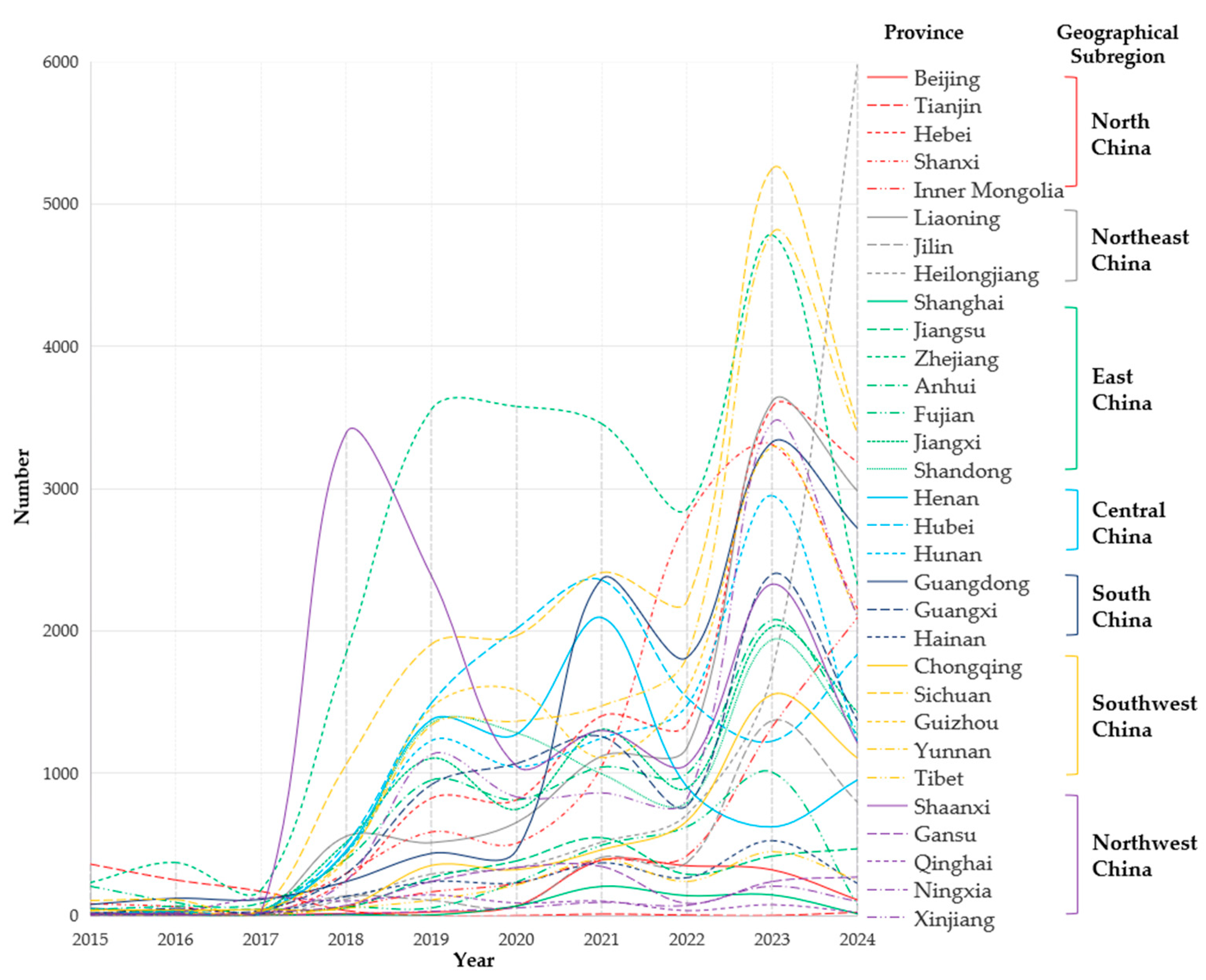

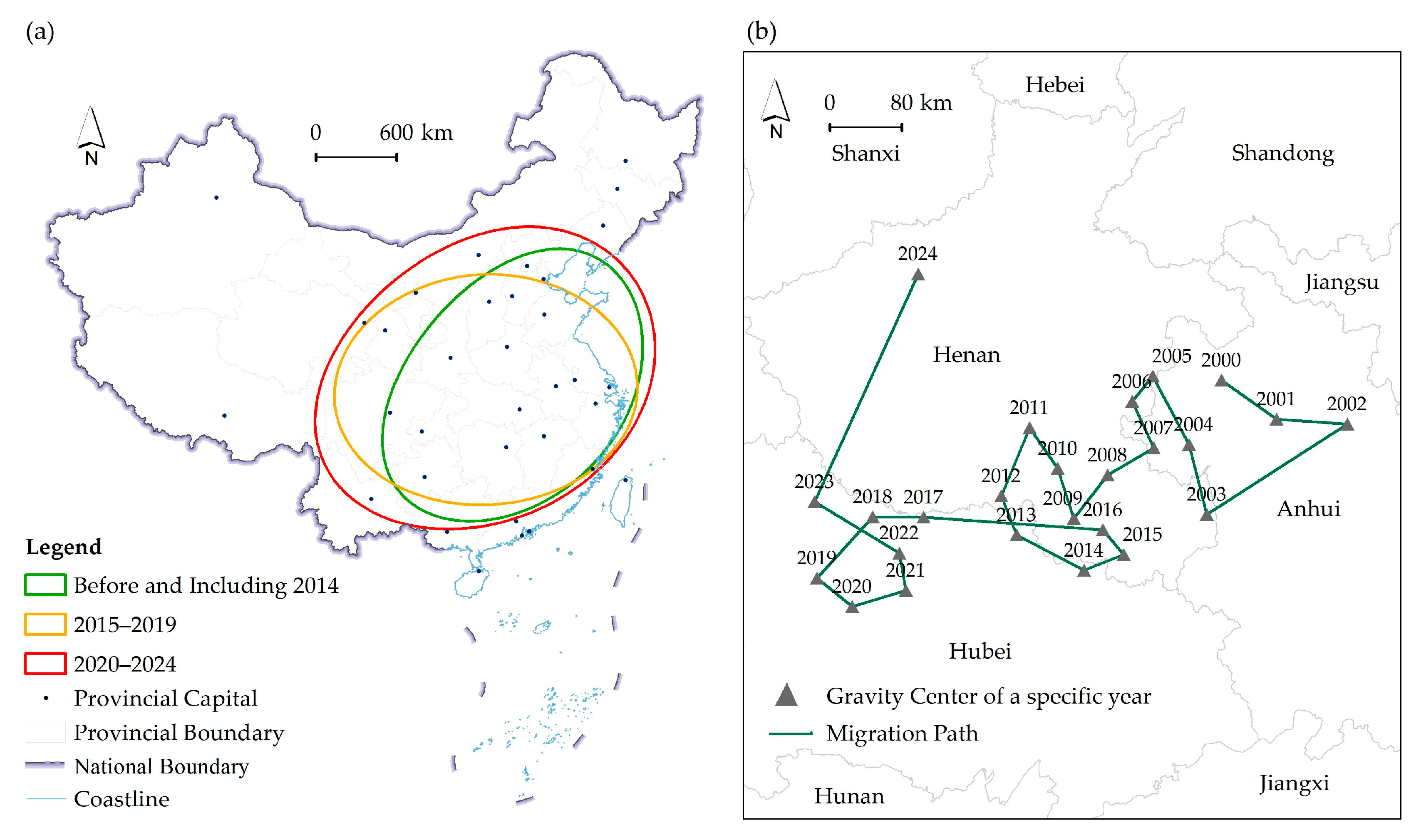


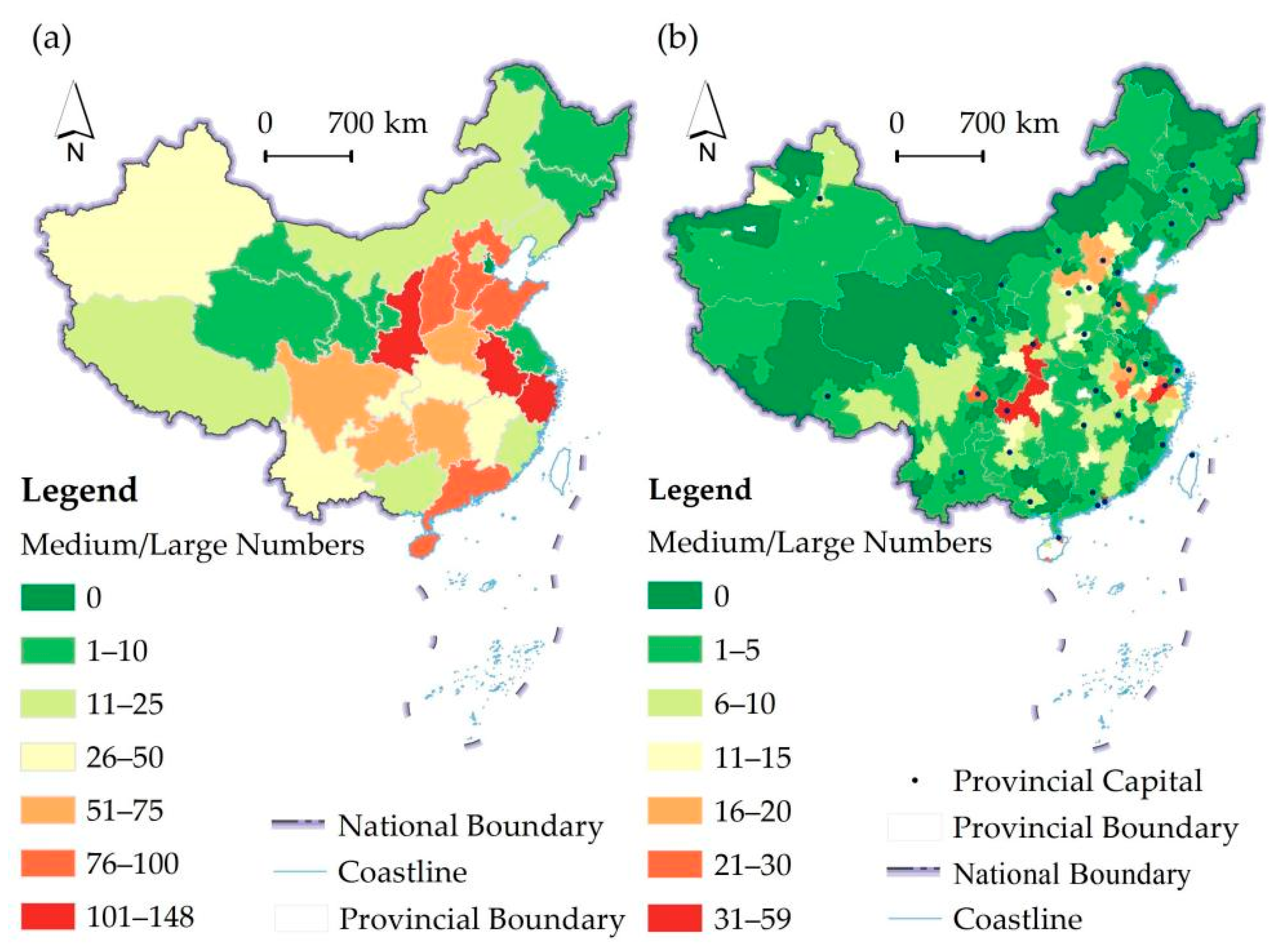
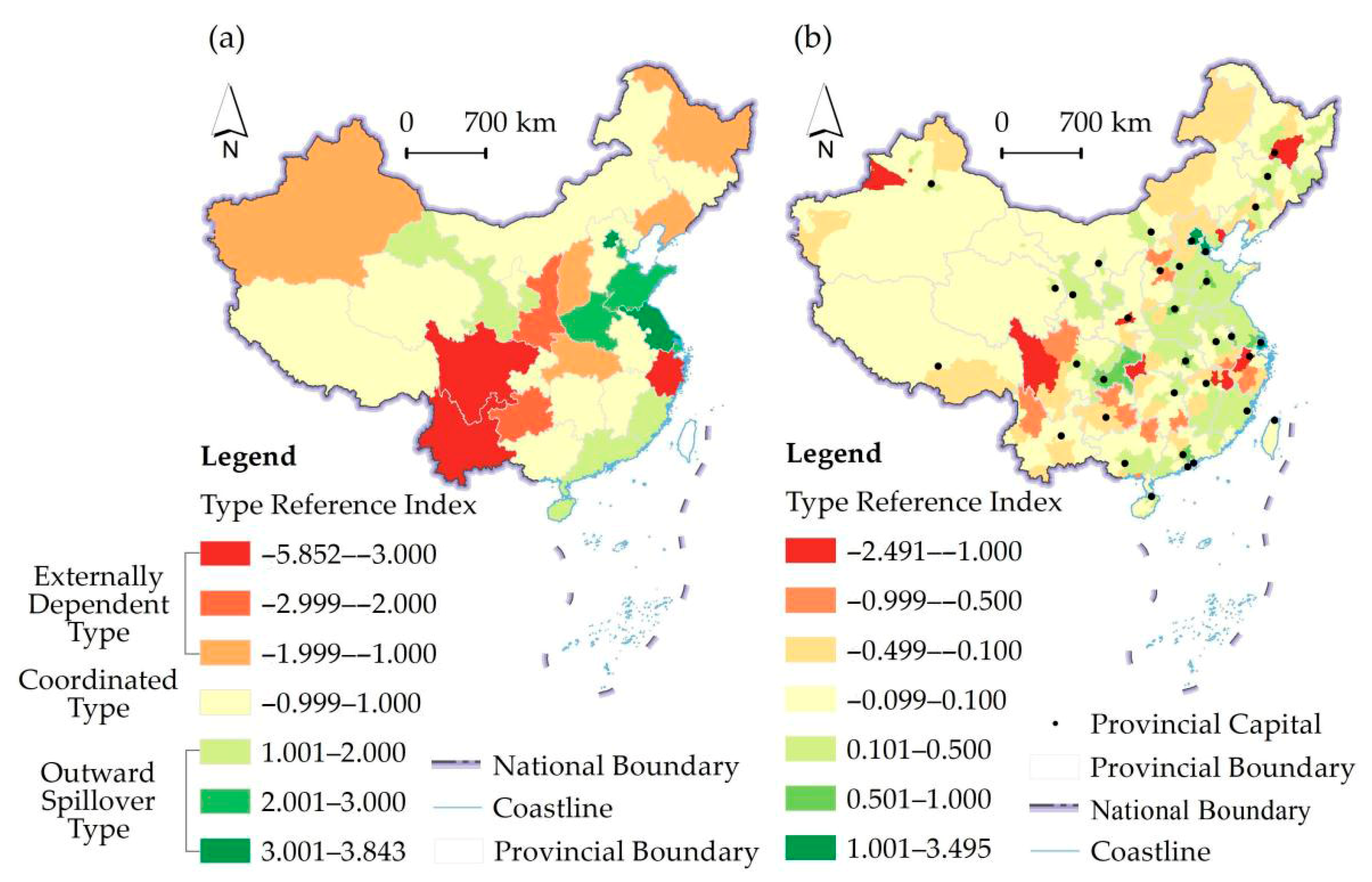
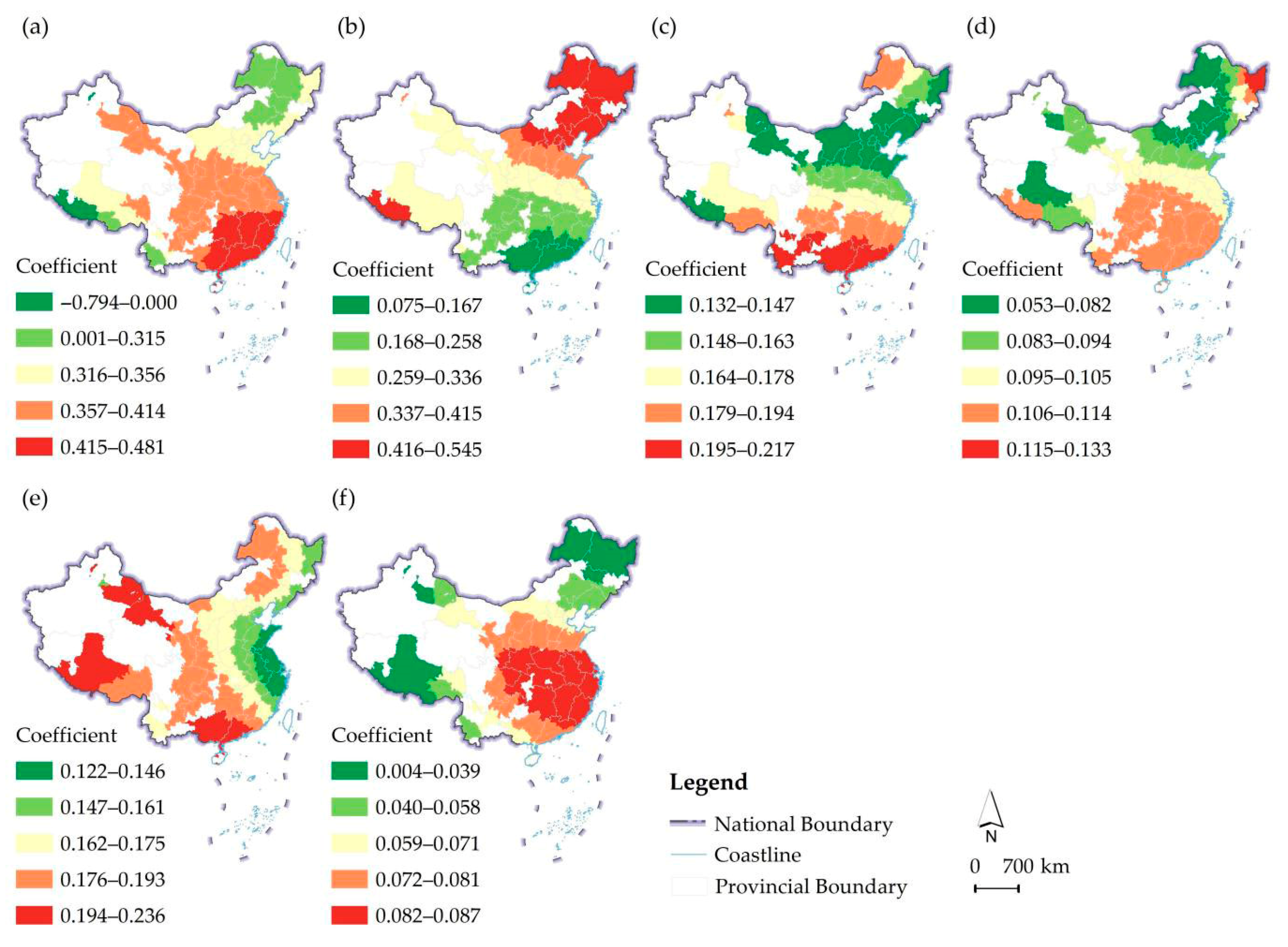
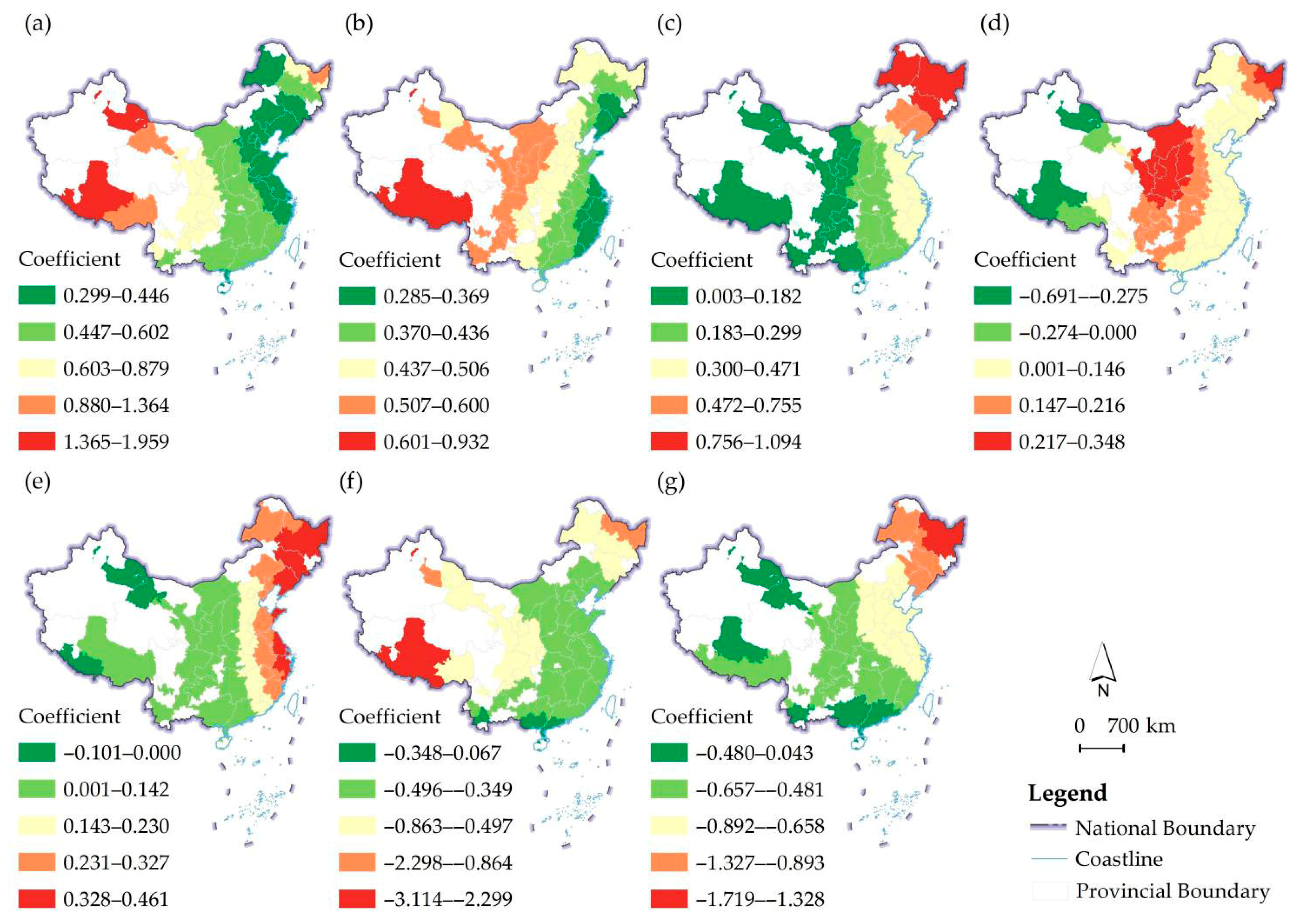
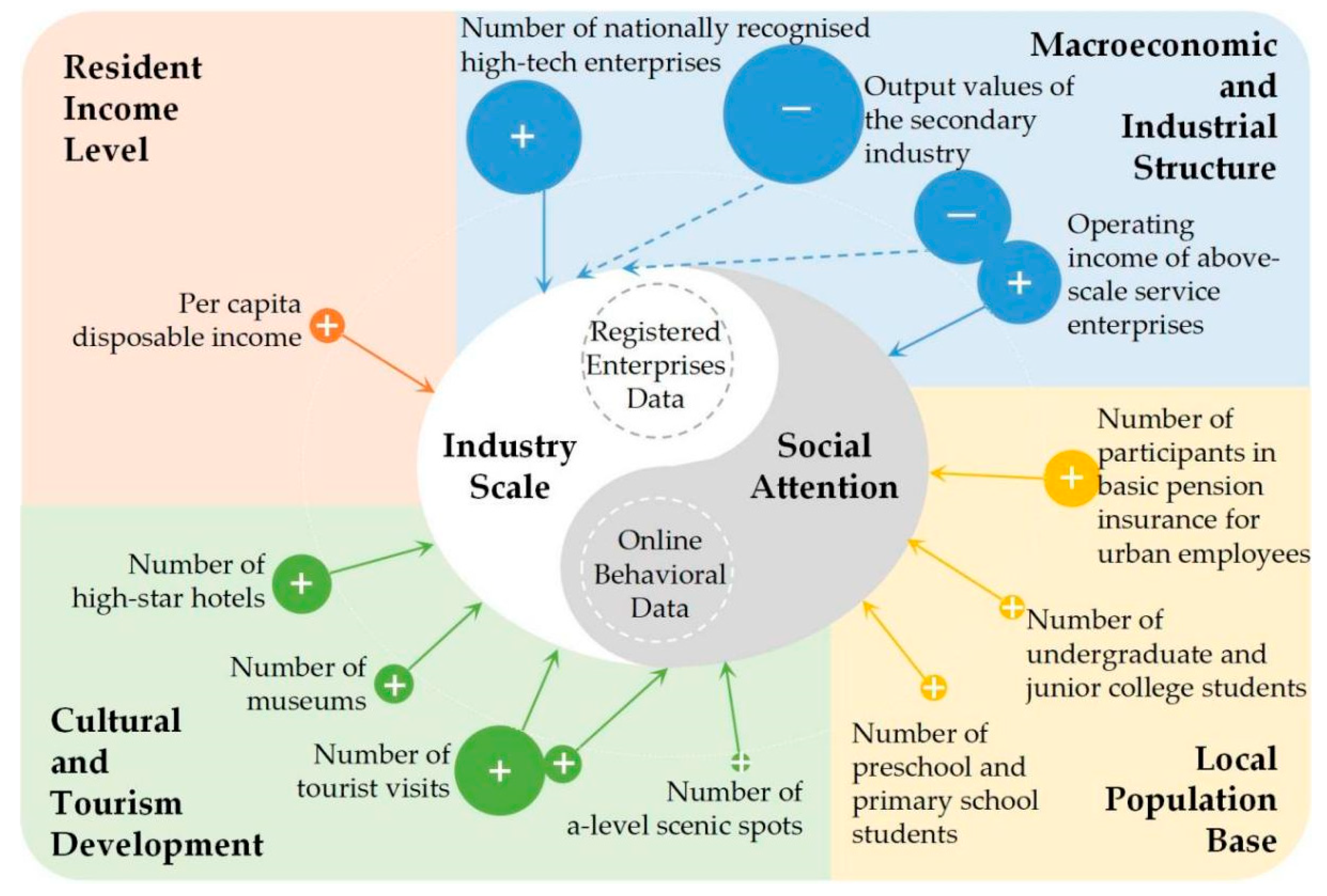
| Spatial Region | Social Attention Index | Industry Scale Index | ||
|---|---|---|---|---|
| Number | Regional Density | Per Capita Number | ||
| National Provincial | 0.145/2.493 | 0.284/4.015 | ||
| National Municipal | 0.051/5.594 | 0.015/1.780 | 0.027/3.130 | 0.077/8.828 |
| North China | 0.074/1.906 | 0.204/2.860 | ||
| Northeast China | 0.154/3.209 | |||
| East China | 0.403/5.703 | 0.196/3.028 | ||
| Central China | 0.152/1.820 | 0.340/5.411 | ||
| South China | 0.220/8.440 | 0.025/1.716 | ||
| Southwest China | 0.094/2.659 | |||
| Northwest China | 0.019/2.246 | |||
 Random
Random  Clustered (p < 0.1);
Clustered (p < 0.1);  Clustered (p < 0.05);
Clustered (p < 0.05);  Clustered (p < 0.01).
Clustered (p < 0.01).| Dependent Variable | Parameters of the OLS and GWR Model | Independent Variable | Standardized Regression Coefficient | VIF |
|---|---|---|---|---|
| Industry Scale Index | Adjusted R2: 0.439/0.524 AICc: 679.687/639.651 p-value: <0.001 Residual test pass rate: 95.93% Local R2: 0.386–0.804 | Number of nationally recognized high-tech enterprises | 0.541 *** | 8.588 |
| Number of tourist visits | 0.428 *** | 3.572 | ||
| Number of high-star hotels | 0.282 ** | 4.287 | ||
| Number of museums | 0.184 * | 3.501 | ||
| Per capita disposable income | 0.168 * | 2.392 | ||
| Operating income of above-scale service enterprises | −0.488 *** | 2.766 | ||
| Output values of the secondary industry | −0.663 *** | 5.907 | ||
| Social Attention Index | Adjusted R2: 0.945/0.957 AICc: −9.281/−75.513 p-value: <0.001 Residual test pass rate: 96.27% Local R2: 0.930–0.987 | Operating income of above-scale service enterprises | 0.395 *** | 2.640 |
| Number of participants in basic pension insurance for urban employees | 0.273 *** | 9.037 | ||
| Number of tourist visits | 0.181 *** | 3.104 | ||
| Number of undergraduate and junior college students | 0.122 *** | 2.443 | ||
| Number of preschool and primary school students | 0.123 *** | 6.426 | ||
| Number of A-level scenic spots | 0.089 *** | 2.220 |
| Primary Indicators | Secondary Indicators | Data Sources in China | Data Sources Outside China |
|---|---|---|---|
| Industry Scale Index | Enterprise Data | Tianyancha | Crunchbase, PitchBook, Orbis, Companies House, Dun & Bradstreet |
| Social Attention Index | Search Engine Data | Baidu Index | Google Trends |
| Social Media Data | Ocean Engine data | Brandwatch, BuzzSumo, TweetReach, Keyhole (for Twitter/X) |
Disclaimer/Publisher’s Note: The statements, opinions and data contained in all publications are solely those of the individual author(s) and contributor(s) and not of MDPI and/or the editor(s). MDPI and/or the editor(s) disclaim responsibility for any injury to people or property resulting from any ideas, methods, instructions or products referred to in the content. |
© 2025 by the authors. Licensee MDPI, Basel, Switzerland. This article is an open access article distributed under the terms and conditions of the Creative Commons Attribution (CC BY) license (https://creativecommons.org/licenses/by/4.0/).
Share and Cite
Wang, S.; Zu, M.; Yuan, J.; Xie, H. A Multi-Platform Online Data-Driven Diagnostic Approach for Macro-Level Sustainability of Homestays. Sustainability 2025, 17, 8230. https://doi.org/10.3390/su17188230
Wang S, Zu M, Yuan J, Xie H. A Multi-Platform Online Data-Driven Diagnostic Approach for Macro-Level Sustainability of Homestays. Sustainability. 2025; 17(18):8230. https://doi.org/10.3390/su17188230
Chicago/Turabian StyleWang, Shujia, Minmin Zu, Jiana Yuan, and Huizi Xie. 2025. "A Multi-Platform Online Data-Driven Diagnostic Approach for Macro-Level Sustainability of Homestays" Sustainability 17, no. 18: 8230. https://doi.org/10.3390/su17188230
APA StyleWang, S., Zu, M., Yuan, J., & Xie, H. (2025). A Multi-Platform Online Data-Driven Diagnostic Approach for Macro-Level Sustainability of Homestays. Sustainability, 17(18), 8230. https://doi.org/10.3390/su17188230





